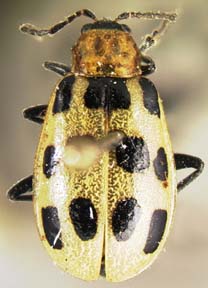
Leaf Beetles
A gallery of typical Chrysomelidae (click here).
Identification:
Form oval, stout or wide bodied, nearly hemispherical in shape. The body shape of many resemble the Coccinellidae. Related to Family Cerambycidae, the Longhorn beetles. Species in this family are small to moderately sized, nearly always less than 12mm long (Borror, et al. 1989). Members of this family are very common, usually brightly colored insects numbering over 25,000 species worldwide, and about 1,500 in north America (Bland,1978).
The elytra cover the tip of the abdomen or leave only the last segment exposed (Borror, et al. 1989).
Antennae are filiform and usually less than 1/2 of body length (Bland,1978). The head is easily visible from above. The prothorax (1st thoracic segment, bearing the anterior legs but no wings) is without notopleural sutures (Borror, et al. 1989).
Tarsi are the most distinguishing characteristic. The tarsal segments are wide and flattened, thickly padded beneath with velvety hairs (Lanham, 1964). Chrysomelidae tarsal segmentation appears 4-4-4, but is actually 5-segmented, with the 4th segment an extremely reduced ring at the base of the 5th segment. Often times dissection is the only way to view the 4th segment. The 3rd segment is enlarged to form a kidney-shaped pad, and the last (5th) is long and slender, appearing to be attached within the median incision of the 3rd (Ross, 1965). The legs are usually short.
Larvae descriptions vary, but most are stout grubs with short legs and antennae. They are soft-bodied and brightly colored. Some bear spines or processes, or are partially covered with their own excrement (Bland,1978). The eggs are long and flat. The eggs are usually elongated and yellowish.
Natural History:
Related to Family Cerambycidae, the Longhorn (or Longicorn) beetles because of similar tarsal structures. The structure of the tarsi seems to have been adapted for clinging onto foliage (Lanham, 1964).
Members of this family are phytophagous. Adults feed on flowers and foliage, the larvae are leaf miners, bore into stems or feed on roots. There is evidence in certain Chrysomelids of constant associations with micro-organisms. This type of behavior occurs when an insect feeds primarily on a single food source, often causing a deficiency in the diet. These micro-organisms supply the needed nutrients to fulfill this deficiency. In certain Chrysomelids, this occurs when micro-organisms from the female accesory glands are smeared onto the outside of the eggs as they are laid. When the outer shell of the egg is then eaten as the insect hatches, the micro-organisms are also consumed (Chapman,1982).
The eggs are deposited on leaves, stems, or are laid in the soil or under bark. Some live in ants' nests and a few are aquatic (Gillot, 1980).
Defense behavior consists of withdrawing legs under body and falling to the ground when disturbed. Some drop when they see movement. Others simply cling to the leaf (Lanham, 1964). Occurring in certain Chrysomelids are chemicals called Cardenolides. These chemicals are effective against some vertebrate predators, such as birds. Some chrysomelids produce cardiac glycosides, another toxin. Some larvae cover themselves with their own excrement to create an "artificial shield", and while the excrement is not toxic, it is distasteful and makes them less visible (Gullan,1994).
Many species in this family are commercial agricultural pests, and are therefore considered to be important economic species. Examples of agricultural pests in this family include:
Asparagus beetle Crioceris asparagi. This is a common pest to the asparagus plant, gnawing holes into the heads of the asparagus and laying their eggs on them. The larvae also feed on the tips. About 6mm long. Colorful beetle of red, black and yellow.
Colorado potato beetle Leptinotarsa decemlineata. This species is one of the most damaging pests of the potato and can be devastating. Both the adults and the larvae feed on the foliage. This is one of the larger species in the family (Comstock, 1920).
Flea beetle GeneraPhyllotretaandEpitrix. The adults feed on the leaves, and the larvae consume the roots of cabbage, turnips, potatoes, grapes, cucumbers, tobacco, eggplants, and tomatoes among others. So-named because of their jumping ability (Gillot, 1980; Ross, 1965).
Grape root-wormFidia longipes. This is the most destructive insect to the grape east of the Rocky Mountains. About 6mm long. They destroy the leaves, vines and roots.
Striped cucumber beetle Acalymma vittata. This species acts as an intermediate host of disease-producing organisms which cause wilting in the leaves (Gillot, 1980).
Striped squash beetle. Bores into the roots or stems of plants (Comstock, 1920).
Members of this family have also been used as biological control agents, introduced to control certain plant populations. An example of this was between 1944 and 1948 in California when Chrysolina quadrigemina was used to control Klamath weed reducing it to 1% of its original abundance (Borror, et al. 1989).
Many species overwinter as adults.
Literature Cited:
Bland, R. G. 1978. How to Know the Insects, 3rd Edition. Dubuque, Iowa, Wm. C. Brown Company Publishers.
Borror, D. J., Triplehorn, C. A., and Johnson, N. F. 1989. An Introduction to the Study of Insects, 6th Edition. New York, Saunders College Publishing.
Chapman, R. F. 1982. The Insects: Structure and Function, 3rd Edition. Cambridge, Mass, Harvard University Press.
Comstock, J. H. 1920. An Introduction to Entomology. Binghamton, New York, Vail-Ballou Press.
Gillot, C. 1980. Entomology. New York, Plenum Press.
Gullan, P. J. and Cranston, P. S. 1994. The Insects: An Outline of Entomology. London, Chapman & Hall.
Lanham, U. N. 1964. The Insects. New York, Columbia University Press.
Ross, H. H. 1965. A Textbook of Entomology. New York, J. Wiley.